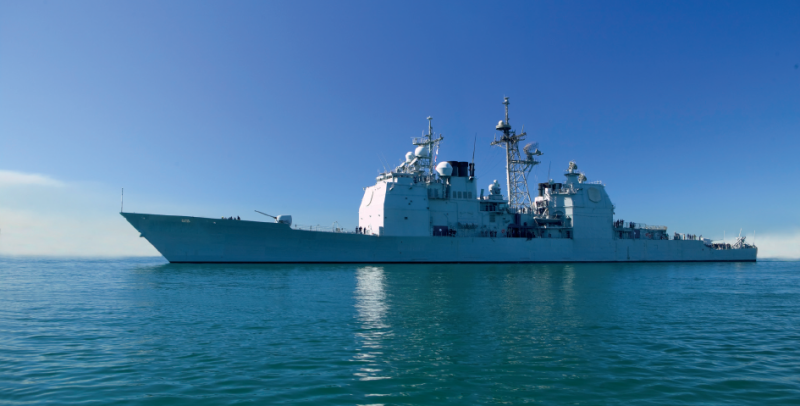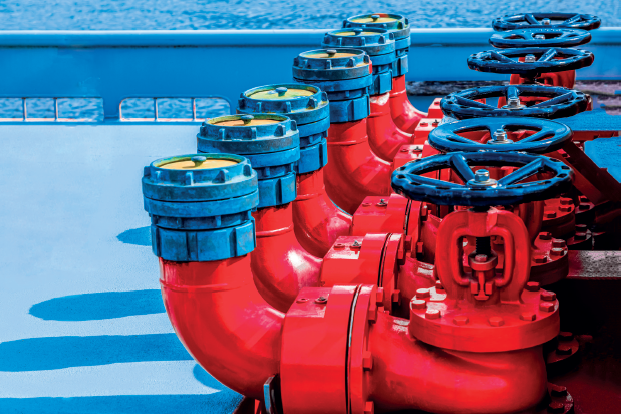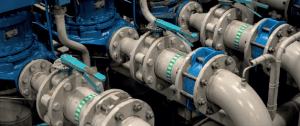At the start of the year, the Congressional Budget Office (CBO) analysed the Navy’s plan for its future fleet over a timespan of three decades. The CBO indicates that “the Navy wants to build a larger fleet whose firepower is distributed among more ships than it is today” at an average cost of $40 billion per year. Time for Valve World Americas to look more closely at valves destined for marine use.
By KCI Editorial
Valve Scope
The number and scope of valves required for ships is much wider than might first be imagined. With applications including fuel lines, steam lines, fire-fighting systems, drinking water, sewage water, bilge control, ballast systems, cargo loading and unloading, and compressed air to name just a few, merchant and naval vessels are home to a wide array of gate, globe, check, ball, butterfly and pressure relief valves. For example, gate valves are commonly found in on/off services in ballast and fuel oil systems, where minimal pressure drop is a concern.
Meanwhile, globe valves are a standard selection for temperature control systems and steam lines due to their ability to manage flow precisely. Ball valves are also used widely on board, such as in fuel and water services. Check valves are commonly utilized in bilge pumping systems and for that matter in any on-board application where reverse flow must be prevented. Butterfly valves are found in HVAC systems, seawater intake, and ballast systems, especially for larger diameter piping due to their compact sizes. Pressure relief valves will be seen in boiler systems, fuel oil systems, and pressure vessels – i.e., wherever overpressure could be a concern. Even the humble solenoid valve is also present in increasingly large numbers, such as in automated systems such as ballast control and machinery cooling systems.

The marine world uses additional valve categories which may sound unfamiliar in process circles. Storm valves (sometimes called scupper valves) are for example a specific type of swing-check valve and often fitted with a counterweight. Installed to shipside sewage system outlets, they enable sewage to be discharged overboard whilst ensuring that in the event conditions suddenly change, sewage and/ or seawater cannot backflow into the sewage system. Storm valves normally have a handwheel, enabling crew to firmly lock the valves in the closed position should the need arise.
Some applications too are specific to ships. Consider for example the bilge and ballast systems. Ballast control refers to the (partial) filling or emptying of specific tanks during the process of loading or unloading cargo in order to maintain ship’s stability. The bilge refers to the lowest part of a ship, where excess water accumulates. A system of valves and pumps is used to remove all such water, to maintain the vessel’s integrity.
Valve Issues
It’s no surprise to learn that valves installed on ships can suffer the same issues as those on land, such as internal and external corrosion, wear and tear of gaskets and packings, blockages, etc. However, the unique environment on board ships calls for extra attention to detail. Hence external corrosion is an area that receives more attention on valves destined for marine applications.
Materials and/or protective coatings are chosen that provide suitable corrosion-resistance to seawater. In some instances, cathodic protection may also be used to mitigate corrosion in submerged valves. Regular inspection of the installed valve base remains the name of the game. Most manufacturers therefore offer ship’s valves in a wide range of materials, including stainless steel, steel, brass, PVC, CPVC, PVDF, etc. More exotic materials are also available.
Stra-Val for one has a range of sea-water valves (up to 3”) available in titanium, Hastelloy, Monel and Alloy 20. Similarly, leakage and failure of gaskets, packings and seals can also be an issue on board ships, with problems exacerbated by the extra vibration associated with vessels. Moreover, the often confined spaces and lack of proper access to valves can also contribute to improper installation of replacement parts.
Pipes and valves on ships are also more prone to ‘foreign object deposits’ than equivalent systems on land. For this reason, strainers and filters are often fitted upstream of critical valves, with regular flushing of pipelines also recommended. Technician training courses for the marine sector consistently emphasize the need for regular checks of items such as valves. They also discuss maintenance and repair procedures which may be less familiar to those onshore. In an emergency situation, for example, a temporary solution for leaking pipes and valves can be the use of a ‘cement box’. This relies on fast-setting cement which is poured into an improvised wooden box around the failed component. The solution may sound crude but can enable the vessel to continue its journey until proper repairs can be effected at port.
Raising The Safety Bar
To ensure a ships’ integrity, and improve safety for passengers and crew, several bodies worldwide investigate accidents, identify root causes, and recommend improvements in system designs as well as operational procedures. A quick search reveals that valve-related incidents can certainly be found among the list of accidents, although typically the problems are not due to the valves per se.
For example, a report by Marine Insight1 discusses how a tanker carrying MTBE (methyl tertiary butyl ether) suffered a cargo overflow though a drop valve on a cargo tank. Apparently, the ship’s practice was to tie up the manual drop valves with rope to indicate they were in the closed position. In a chain of errors, not only was a specific valve in fact not properly closed, but an officer failed to correctly identify a subsequent audible alarm. Moreover, multiple valves were opened up which were not required plus there was a failure to physically check the status of the valves. Needless to say that corrective actions have been taken.
A second incident with a valve dimension involves a vessel named the ‘Joanne Marie’, which was found partially sunk after having being moored and deactivated at a shipyard in the USA. The cause was discovered to be an obstructed check valve on a bilge pump discharge line. Apparently a wire nut had become lodged in the spring-loaded check valve. That alone would not have led to the sinking, had the shutoff valve located before the through-hull pipe not been left open. Procedures have since been modified to prevent such incidents in the future.
Market Expectations
The global shipping sector is currently in the ascendency, leading to many orders for extra vessels – and valves of course. For example, in their February 2025 report, Market Research Intellect value the 2024 global marine actuator and valve market at USD 9.42 billion and project growth to reach USD 20.53 billion by 2031, reflecting a CAGR of 13.86%. They ascribe this strong figure to increasing demand, technological advancements, and a focus on sustainability.
These figures are for merchant shipping only, such as passenger ships, cruise liners, cargo vessels, tankers, special purpose vessels, service vessels, fishing vessels, etc. However, incidental data available for the naval sector indicates a similarly positive outlook.

Hence early this year, a press release from Hunt Valve in the USA indicated that the company had been awarded major purchase orders (totalling USD 96 million) for essential valves for the Virginia and Columbia-Class submarine programs. The scope includes ship service ball valves and forged high-pressure system valves.
Snapshot: Marine Valve Suppliers in the USA
MetrexValve manufactures water regulating valves for commercial, marine and nuclear HVAC. In a recent blog post, the company reflects on the CBO’s annual analysis of the US Navy’s spending plans and considers implications for the US’s industrial base. There will almost inevitably be a requirement for extra facilities and manpower given the expected ongoing increases in naval tonnage across various types of vessels. Indeed, MetrexValve notes that some 100,000 new workers could be required over the next decade to facilitate the industrial base for submarines alone.
Meanwhile, Warren Valve offer a wide range of gate, globe, check and ball valves to the marine sector, in sizes ranging from ¼” to 48”. Interestingly, they note that:
In addition to metallic solutions, plastic valves have also shown their worth in marine applications. Hence Asahi/America states that their marine client base includes the merchant navy, offshore oil sector, commercial fishery and cruise companies. Plastic valves and actuators can be found in numerous areas, including: hot and cold fresh water, black and grey water; ballast water treatment; freshwater ballast and bunker; fresh seawater cooling, etc.
Rounding up this very limited snapshot, Parker lists solenoid valves as being amongst its product offerings suited for marine use. Applications include: onboard control of actuators and valves; water, steam, light oils control; onboard firefighting systems; diesel and petrol fuel versatility; fuel supply while tank switching. A broad range of products are approved for usage in vessels classed DNV-GL.
Increasing Sophistication
Finally, many observers suggest that the marine industry as a whole is poised for transformation, in step with changes in other industries. As ships become increasingly complex, the demand for more automated and sophisticated control systems will grow. Remote monitoring will also be more widely deployed on board, in line with the trend to invest in smart systems. Other drivers that could lead to investment in more sophisticated valve systems include the enhanced focus on safety and compliance, the drive for sustainable solutions, and advancements in cybersecurity.



